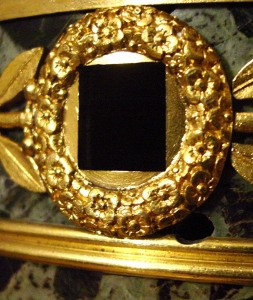Three Graces by Thomire
IMPORTANT!!! The clock belong to the MUSA family collection and IS NOT FOR SALE!
Pierre Philippe THOMIRE Clock with Three Graces, Owned by the Maréchale-Duchess of Montebello, Movement by Louis Moinet l’Aîné
Period and provenance: circa 1814/1815, Paris - France.
This clock belonged to the Maréchale and Duchess of Montebello, Princess of Sivers, who was lady in waiting to Empress Marie Louise.
The clock had in fact been constructed for her husband, Maréchal Lannes, Maréchal de L’Empereur, Colonel Général of the “Suisses” and a friend of Napoleon I. He, however, died before taking possession of the clock, which he bequeathed to his wife. The body of the clock, created by Philippe THOMIRE, is made up of three magnificent gilt bronze statues representing the three Graces, standing on an antique green marble base containing the clock with revolving dial.
This clock is more noteworthy for the superb execution of the three gilt bronze Graces than for any horological complications.
_______________________________________________
The three Graces, sculpted by Philippe Thomire, represent Thalia, Euphrosina, and Aglae, the daughters of Zeus, representing respectively good cheer, joy, and beauty. They are dressed in classical draperies. Between them rises a basin with a gadrooned base whose lip is decorated with a laurel leaf frieze.
The three Graces stand on a cylindrical verde antico marble base with applied gilt and chased bronze ornaments. The base has a cornice chased with leaf motifs and is encircled with a laurel leaf frieze. There is a central aperture for the digital indication of the hours and minutes. The base is ornamented with candelabras, floral swags, lyres and laurel wreaths. The winding and setting square is hidden by one of the lyres.
This clock stands out among the decorative objects of its period, both for its subject and for its impressive dimensions. Though neo-classical in style, it is reminiscent of the creations of the Renaissance, and clearly appears to have been inspired by the famous group of the three Graces by Germain Pilon (1535-1590).
In the late 18th century, Thomire had produced several groups of the three Graces, all different but always arranged in the same fashion so as to serve as supports to chandeliers; this clock, however, is unlike any known model.
It is surprising that in this case Thomire chose to place the movement in the column that serves as a pedestal, rather than in a globe or vase, as was usually the case.
The basin surmounting the three Graces was intended as a receptacle for floral arrangements. This is unusual for a clock, and is indicative of the evolution of interior decoration in the late 18th and early 19th centuries. Floral arrangements had become extremely important in decorating schemes, as is demonstrated by the increasing number of jardinières and vases for bouquets, which had never before been present to so great a degree in the home.
Louis MOINET l’AINE
From the late 19th century until at least 1825, Thomire worked with horologist Louis Moinet l’Aîné. The latter is recorded in the rue de la Poterie in Paris. Little biographical information is available on this extremely skilful clockmaker. He should not, however, be confused with the Louis Moinet (1768-1853) who worked with Abraham-Louis Breguet as of 1811, and who wrote a “Nouveau traité général, d’astronomie et civil d’horlogerie théorique et pratique” in 1848.
Moinet l’Aîné was clearly Pierre-Philippe Thomire’s preferred horological partner. One rarely finds a Thomire clock after 1800 that is signed by another horologist.

 Back
Back English
English  Italiano
Italiano 







